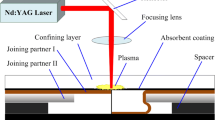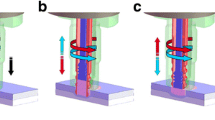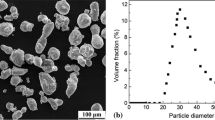Abstract
The laser shock adhesive-clinching (LSAC) is an original material joining technique that combines the advantages of clinch-bonded hybrid joining and laser shock clinching, in which two metal foils are bonded by adhesive and clinched by laser shock simultaneously. In this paper, the LSAC joints are manufactured by 1060 Al foils, Henkel EP 5055 adhesive, and perforated 304 stainless steel sheets. Through experiments and FEM simulations, the LSAC process and the deformation of LSAC joints under shear loads are analyzed, and the effect of adhesive on LSAC joint manufacturing is investigated. The results show that bulging is the dominant deformation behavior during LASC, and the cured adhesive with thin thickness is beneficial to the subsequent clinching process. The shear strength of the LSAC joint is greatly enhanced compared to the pure clinched and pure bonded joints. The shear failure process of the LSAC joint is adhesive degumming first, then the interlock separating.

















Similar content being viewed by others
Availability of data and materials
All data generated or analyzed during this study are included in this published article.
Code availability
Not applicable.
References
Mayyas A, Qattawi A, Omar M, Shan DR (2012) Design for sustainability in automotive industry: a comprehensive review. Renew Sustain Energy Rev 16(4):1845–1862
Taub A, Moor E, Luo A, Matlock D, Speer J, Vaidya U (2019) Materials for automotive lightweighting. Annu Rev Mater Res 49(1):327–359
Zhang DW, Huang Y (2021) Influence of surface roughness and bondline thickness on the bonding performance of epoxy adhesive joints on mild steel substrates. Prog Org Coat 153:106135
Peng H, Chen C, Ren XQ, Wu JL (2022) Development of clinching process for various materials. Int J Adv Manuf Technol 119:99–117
Maggiore S, Banea MD, Stagnaro P, Luciano G (2021) A review of structural adhesive joints in hybrid joining processes. Polymers 13(22):3961
He XC (2017) Clinching for sheet materials. Sci Technol Adv Mater 18(1):381–405
Wines B (1989) Adhesive and mechanical clinch bond strengths - a comparison to spot weld strengths. International Congress and Exposition. SAE Technical Paper 890517
He XC, Zhao L, Yang HY, Xing BY, Wang YQ, Deng CJ, Gu FS, Ball A (2014) Investigations of strength and energy absorption of clinched joints. Comput Mater Sci 94:58–65
Lei L, He XC, Zhao DS, Zhang Y, Gu FS, Ball, (2018) Clinch-bonded hybrid joining for similar and dissimilar copper alloy, aluminium alloy and galvanised steel sheets. Thin-Walled Struct 131:393–403
Balawender T, Sadowski T, Golewski P (2011) Experimental and FEM analyses of clinched and adhesively bonded hybrid joints. J Adhes Sci Technol 25:2391–2407
Sadowski T, Balawender T (2011) Technology of clinch–adhesive joints. Adv Struct Mater 6:149–176
Moroni F, Pirondi A, Kleiner F (2010) Experimental analysis and comparison of the strength of simple and hybrid structural joints. Int J Adhes Adhes 30:367–379
Balawender T, Sadowski T, Kneć M (2011) Technological problems and experimental investigation of hybrid: clinched - adhesively bonded joint. Arch Metall Mater 56(2):439–446
Pinger T, Bossche NV (2022) On the influence of zinc coating and outdoor exposure on the strength of adhesive, clinched, and hybrid joints of batch hot-dip galvanized steel. Int J Adv Manuf Technol 118:4031–4042
Calabrese L, Galtieri G, Borsellino C, Bella GD, Proverbio E (2016) Durability of hybrid clinch-bonded steel/aluminum joints in salt spray environment. Int J Adv Manuf Technol 87:3137–3147
Xing BY, He XC, Feng M (2012) Analysis on influence of adhesive on strength of clinched joints with mathematical statistics. International Material Review 26(1):56–59
Liu F, He XC, Xing BY (2014) Influence of material property on clinched and hybrid joints performance. Journal of Hot Work Technology 43(11):162–165
Friedrich S, Georgi W (2013) Gehde M (2013) Hybrid joining technology - a new method for thermoplastic to metal. ANTEC Conference Proceeding 2:1669–1675
Friedrich S, Georgi W, Gehde M, Mayr P (2014) Hybrid joining technology - a new method for joining thermoplastic-metal-mixed components. AIP Conf Proc 1593:121–127
Zhuang WM, Shi HD, Li M (2019) Curing effects on forming and mechanical performance of clinch-adhesive joints of dissimilar materials between AA5754 Aluminum Alloy and Q235 steel. J Adhes 95(5–7):577–594
Pirondi A, Moroni F (2009) Clinch-bonded and rivet-bonded hybrid joints: application of damage models for simulation of forming and failure. J Adhes Sci Technol 23(10–11):1547–1574
Balawender T, Sadowski T, Golewski P (2012) FEM analysis and experiments of the clinch-bonded joint subjected to uniaxial tension. Comput Mater Sci 64:270–272
Sadowski T, Balawender T, Golewski P (2015) Technological aspects of manufacturing and FEM modelling of clinch-adhesive joints. In: Technological Aspects of Manufacturing and FEM Modelling of Clinch-Adhesive Joints. SpringerBriefs in Applied Sciences and Technology. Springer: Cham, 2015, pp 1–59
Neugebauer R, Israel M, Mayer B, Fricke H (2012) FEM and experimental studies on the clinch-bonding and riv-bonding process. Key Eng Mater 504–506:771–776
Fricke H, Vallee T, Mayer B (2017) Modelling of industrial hybrid bonding processes considering fluid-structure-interaction. International Conference on Computational Methods for Coupled Problems in Science and Engineering (COUPLED) - VII International Conference on Computational Methods for Coupled Problems in Science and Engineering (COUPLED 2017) Rhodes Island, Greece, 2017
Fricke H, Vallée T (2016) FEM modelling of hybrid-bonded joints. J Adhes 92(7–9):652–664
Ji Z, Liu R, Wang DG, Zhang MH, Su QC (2008) A micro clinching method and its device for joining ultra-thin sheets with pulsed laser. Chinese Patent. ZL200810014018.1
Wielage H, Vollertsen F (2011) Undercuts by laser shock forming. AIP Conf Proc 1353:1309–1312
Veenaas S, Vollersten F (2014) High speed joining process by laser shock forming for the micro range. 6th International Conference on High Speed Forming
Veenaas S, Wielage H, Vollertsen F (2014) Joining by laser shock forming: realization and acting pressures. Production Engineering - Research and Development 8:283–290
Veenaas S, Vollertsen F (2015) Forming behavior during joining by laser induced shock waves. Key Eng Mater 651–653:1451–1456
Zheng C, Pan CD, Wang JL, Zhao GQ, Ji Z (2020) Mechanical joining behavior of Cu–Fe dissimilar metallic foils in laser shock clinching. Int J Adv Manuf Technol 110:1001–1014
Wang X, Qiu TB, Shen ZB, Zhang D, Ma YJ, Gu YX, Liu HX (2016) Forming properties of a microscale laser dynamic flexible forming technique. Mater Manuf Processes 31(6):745–750
Wang X, Zhang D, Gu CX, Shen ZB, Ma YJ, Gu YX, Qiu TB, Liu HX (2015) Micro scale laser shock forming of pure copper and titanium sheet with forming/blanking compound die. Opt Lasers Eng 67:83–93
Wang X, Li XD, Li C, Shen ZB, Ma YJ, Liu HX (2018) Laser shock micro clinching of Al/Cu. J Mater Process Technol 258:200–210
Veenaas S, Vollertsen F (2018) Mechanical joining of glass and aluminum. Key Eng Mater 767:369–376
Veenaas S, Vollertsen F, Czotscher T (2019) Joining by laser induced shock waves of aluminum and plastics. AIP Conf Proc 2113:050029
Wang XY, Ji Z, Wang JF, You SX, Zheng C, Liu R (2018) An experimental and FEM study on laser shock clinching for joining copper foil and perforated stainless steel sheet. J Mater Process Technol 258:155–164
Wang XY, Ji Z, Liu R, Zheng C (2018) Making interlock by laser shock forming. Opt Laser Technol 107:331–336
Wang XY, Ji Z, Zheng C, Liu R (2020) Joining similar and dissimilar material combinations by laser shock forming. J Manuf Process 60:318–327
You SX, Wang XY, Ji Z, Zheng C, Zhang GF, Liu R (2019) Making line undercut structure by incremental laser shock forming. Int J Precis Eng Manuf 20:1289–1296
Wang J, Wang YQ, Wang S, Lu GX, Zheng C (2021) Ji Z (2021) Experimental and FEM investigation on incremental laser shock clinching for joining three sheets of copper/aluminum/stainless steel. Opt Laser Technol 141:107141
Peyre P, Fabbro R (1995) Laser shock processing: a review of the physics and applications. Opt Quant Electron 27:1213–1229
Johnson GR, Cook WH (1983) A constitutive model and data for metals subjected to large strains, high strain rates and high temperatures. 7th International Symposium on Ballistics, Hague, Netherlands, pp 541–547
Henkel AG, Co. KGaA (2014) Technical Data Sheet TEROSON EP 5055
Gerstmann T, Awiszus B (2020) Hybrid joining: FEM process development of flat-clinch-bonding. J Mater Process Technol 277:116421
Funding
This work is supported by the National Natural Science Foundation of China (Nos. 52075298, 51575314, 51801031, 52075299) and the Fund of the State Key Laboratory of Solidification Processing in NPU (No. SKLSP202014).
Author information
Authors and Affiliations
Contributions
All the authors contributed to the study’s conception and design. Material preparation, data collection, and analysis were performed by Yiqun Wang. The first draft of the manuscript was written by Yiqun Wang, and all the authors commented on previous versions of the manuscript. All the authors read and approved the final manuscript.
Corresponding author
Ethics declarations
Ethics approval
Not applicable.
Consent to participate
The authors declare that they consent to participate in this paper.
Consent for publication
This manuscript is approved by all authors for publication.
Competing interests
The authors declare no competing interests.
Additional information
Publisher's Note
Springer Nature remains neutral with regard to jurisdictional claims in published maps and institutional affiliations.
Rights and permissions
Springer Nature or its licensor holds exclusive rights to this article under a publishing agreement with the author(s) or other rightsholder(s); author self-archiving of the accepted manuscript version of this article is solely governed by the terms of such publishing agreement and applicable law.
About this article
Cite this article
Wang, Y., Lu, G., Ji, Z. et al. The small-size laser shock adhesive-clinching of Al foils. Int J Adv Manuf Technol 122, 3837–3848 (2022). https://doi.org/10.1007/s00170-022-10123-4
Received:
Accepted:
Published:
Issue Date:
DOI: https://doi.org/10.1007/s00170-022-10123-4




